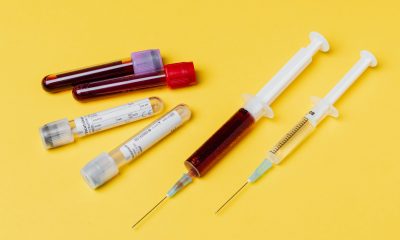Canada News
BC’s opioid users are unable to access safest drugs during pandemic

There’s a problem, however: the guidelines recommend prescription opioid tablets as a replacement for illicit opioids. (Shutterstock photo)
The confluence of two public health emergencies has made life even more dangerous for people at risk of overdose in British Columbia. COVID-19 comes at a time when the province is battling an opioid overdose crisis that has killed at least 5,000 people since April 2016, when the crisis was declared a public health emergency.
The government’s strict self-isolation measures aimed at slowing the spread of the coronavirus can’t work for those who use illicit drugs unless they have an alternative drug supply. Otherwise, they will stave off drug withdrawal by continuing to seek illicit drugs on a daily or near daily basis, engaging in close in physical contact and risky behaviours. It’s a continuous cycle.
Overdose deaths in BC outpace those linked to COVID-19. In April alone, there were 117 overdose deaths. COVID killed 111 in the first 100 days after the province issued its first warning about the virus. Worse, British Columbia has just broken its horrific record for the highest number of overdose deaths in a single month, with 171 people dying in May, according to figures just released by the BC Coroners Service. (Calls to 911 for overdoses in Saskatoon also hit a new high in May, with 262 calls, though not all of those ended in deaths.)
The most significant factor in these overdose deaths is the unregulated illicit drug supply. For most people using drugs, the only option is the illicit drug supply, which is unregulated, with unpredictable drug potencies. As a result, overdose deaths have skyrocketed. Safe supply, or legal access to alternatives to the illicit drug supply, has become a rallying cry for those on the frontlines of the overdose crisis. They recognize that the public health emergency will never end without access to legal regulated drugs.
To respond to both public health emergencies, British Columbia released new clinical guidelines in March for healthcare providers to help support self-isolation among people who use drugs. The BC Centre on Substance Use’s “Risk Mitigation in the Context of Dual Public Health Emergencies” provides clinical guidance and prescription recommendations for people at risk of overdose and COVID-19 so they can self-isolate.
There’s a problem, however: the guidelines recommend prescription opioid tablets as a replacement for illicit opioids. But tablets can be dangerous when they are crushed and injected. They’re not made for injection. Crushing and injecting, however, is a common practice for people who are used to injecting their drugs. Not a single drug on the guideline is regulated or approved for injection use even though injectable opioids exist and are safer, but are restricted. Injectable opioids should be in the guideline. It’s a glaring omission during an overdose crisis with so many using injection drugs.
It should come as no surprise that people crush and inject prescription tablets. People are scared for their lives and trying to avoid the risk of overdosing and dying from illicit fentanyl. They feel reassured by a prescription opioid with no risk of fentanyl contamination and sudden overdose death. For many people, tablet injection is a lifeline.
For years, some frontline service providers, including prescribers, have responded to the overdose crisis by prescribing oral opioid tablets like Dilaudid, for example, because they have no other option. They cannot prescribe injectable pharmaceutical opioids. Now, that long-held failure of Canadian healthcare is becoming a standard practice.
Imagine if we chose to provide people living with diabetes insulin in tablet form to inject because it’s cheaper and simpler to administer despite carrying greater health risks. This would be considered a healthcare failure.
Opioid tablets are the only prescriptions available, and until the new guideline came out in March, they were difficult for many people to access. But they are fully covered under BC’s provincial pharma formulary and dispensed from pharmacies across BC. The injectable opioid hydromorphone, on the other hand, is not allowed to be prescribed, though it has federal regulatory approval that confirms it is safe for use, supported by evidence from clinical trials and years of program experience. But injectable hydromorphone is more complicated: It requires an existing physical infrastructure compliant with regulatory standards to make the drug into an injectable solution, which can be more resource- and cost-intensive. These barriers can and should be overcome, however.
When a person crushes a prescription tablet to inject instead of illicit fentanyl, this is practicing good harm reduction. However, when government recommends tablets to replace injectable drugs, it looks more like a budget consideration that can cost people their health.
The impact of particle injection on the lungs is catalogued in the medical literature as “excipient lung disease.” Other health risks include skin ulcers, cellulitis, blood clots, infective endocarditis, and generalized blood infections.
Tablet injection has health risks that are not trivial. Tablets contain non-medicinal ingredients – excipients – that can block veins when injected, and cause other complications. The impact of particle injection on the lungs is catalogued in the medical literature as “excipient lung disease.” Other health risks include skin ulcers, cellulitis, blood clots, infective endocarditis, and generalized blood infections.
The dual-risk guidelines do not discuss the potential health consequences that can arise from tablet injection. Unless a prescriber knows those risks, informing the patient appropriately is not possible, and the risk of prescriber liability increases. Because the tablets recommended by the guideline are being offered as part of a government intervention, many people will assume these options have gone through a regulatory process that confirms they are safe for injection use, which is not the case. It is the responsibility of BC’s provincial decision-makers to be transparent about the health risks, especially for individuals who have no history of tablet injection and are unaware that effective filtration practices can greatly reduce these risks. Filtration can be done before injection, removing bacteria and tablet particles that could cause vein blockage.
The only prescription opioids made specifically for injection use, injectable hydromorphone and injectable diacetylmorphine (also known as pharmaceutical heroin), are restricted and inaccessible to many in British Columbia who need them. They are used in BC’s injectable opioid-assisted treatment (iOAT) programs, accessible to approximately 220 opioid users in a province with many more thousands of people living at risk of overdose. Prescription heroin is available in Canada only through a special importation license, and only through two iOAT programs in British Columbia, in Surrey and Vancouver’s Crosstown Clinic.
The higher cost of injectable opioids and their limited access are structural issues that must be solved by decision-makers at a higher level. This is not just a British Columbia issue. Injectable opioids are not on most provincial formularies, and many pharma plans don’t cover them.
However, there are tools the provincial and federal governments could use to negotiate with pharma companies for lower prices, different formulations, and greater accessibility to the drug. The pan-Canadian Pharmaceutical Alliance is a collective body that the provinces and federal government can use to negotiate drug prices with pharma companies.
The realities of COVID-19 mean that pharma companies should begin producing injectable opioids in “single use” ampules that can be stored and dispensed much like the tablet drugs on the dual-risk guideline. This would allow more participants in the province’s iOAT program to be given “take home” or “carry” doses rather than have to visit a clinic up to three times every day for each dose.
Expanding access to injectable hydromorphone has other potential benefits: it could interest pharma companies in producing made-to-inject formulations for drugs like diacetylmorphine, or heroinPharma companies that have a physical infrastructure dedicated to producing injectable drugs could be producing opioids as well. What’s missing is a provincial government that wants to increase funding for coverage and programming (including iOAT programming). Widespread access to these drugs has been needed for a very long time, and it will only grow as two public health emergencies continue in British Columbia.
The dual-risk mitigation guidelines are for people seeking relief and safety from an unregulated illicit drug supply. Across Canada, the illicit supply is claiming more lives. Ontario’s coroner recently reported a 25 percent increase in overdose deaths. With more prescriptions being written under the guideline in BC, health complications from tablet injection could increase. Across Canada, this could also be the case, as the Canadian Research Institute for Substance Misuse (CRISM) prepares a national guideline to support physical distancing among people who use illicit drugs.
While prescription tablets provide legal access to opioids, the drugs recommended by the dual risk guideline are not regulated or approved for anything other than oral use. Meanwhile, the safest drugs made for injection use are absent from the clinical guidelines designed to support people who use injection drugs.
There is a very real need for independent government oversight with accountability to drug consumers across Canada to ensure that much-needed alternatives to the illicit drug supply are covered by provincial pharmaceutical formularies, are safe for human use and are inclusive of the different ways that humans use drugs. Transparent information about health risks and their mitigation must also be provided and accessible at all times
This article is part of the The Coronavirus Pandemic: Canada’s Response special feature.
This article first appeared on Policy Options and is republished here under a Creative Commons license.





















